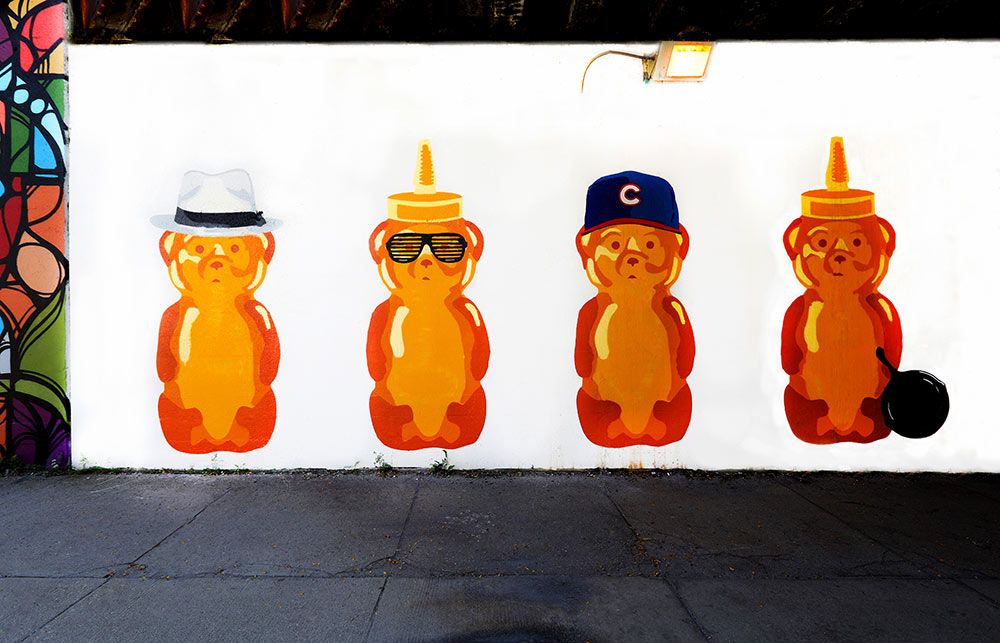一夜之间所有人都开始用NFT卖东西,艺术家也入坑了
旧金山的街头艺人芬奇在今年迎来了突破。去年5月,他发起了“寻找蜂蜜罐小熊”活动(Honey Bear Hunt),城市里到处都是标志性的戴着面具的熊形象。这一想法有艺术的成分,也有游戏的成分。突然之间,他发现自己要往18个国家运20000头熊。
与此同时,芬奇注意到WhIsBe、Matt Gondek、Greg Mike和lushux等街头艺术家出售数字作品大赚了一笔。在线创作附带了名叫NFT(非同质化代币)的数字证书,该证书可以记录所有权,证明专属数字资产的真实性。其主要好处是,一旦记录下某笔交易就永远无法改变,从而解决了困扰艺术界数个世纪的赝品问题。代币也能够在交易所买卖交易,为作品增加感知价值。
到了3月,NFT市场已经相当火爆,艺术家贝普尔以6900万美元高价出售了耗费5000天创作的数字图像拼贴作品,超过了许多梵高、莫奈和毕加索画作的价格。突然间,所有人都在用NFT卖东西。推特(Twitter)的首席执行官杰克·多尔西出售了自己发的第一条推文。音乐家格里姆斯出售视频作品。篮球巨星勒布朗·詹姆斯用NFT卖出了一盘顶级投篮精选集。在闸门大开之后,一大帮创作者涌向热闹的社交音频聊天应用程序Clubhouse,科技精英聚集在此分享宏大创意,比如如何利用热潮变现。
这时,芬奇接到朋友乔西·康斯丁的电话,他通过自己的风投公司SignalFire向Clubhouse投了钱,也在平台上主持了热门节目。他准备邀请平台上360万粉丝跟Facebook的首席执行官马克·扎克伯格、Spotify的首席执行官丹尼尔·埃克和Shopinify的首席执行官托比亚斯·卢特克开展难得的对话。他还认为芬奇可以考虑为三部曲创建NFT然后拍卖,将部分收益捐给慈善机构。
结果没到25小时就筹到了7万美元。
芬奇立刻上了瘾,决定再试一次,周日为了逾越节庆典Value Culture慈善活动用NFT拍卖艺术品。这场由Clubhouse主办的盛会当然也会在Buzzfeed美味的YouTube频道上直播,马克·安德森和本·霍洛维茨等硅谷重量级投资大佬也将出席。
为了保持节日传统,芬奇创造了“数字afikomen”,也就是渲染的逾越节薄饼,薄饼分成两半,其中一半藏起来让观众寻找,另一半拍卖。“纯粹是为了好玩。技术能够做的事情太多,我们才刚开始触及创造性玩法的皮毛。”
至于芬奇的艺术是不是因为NFT才升值10倍,他大声表示否定:“我对自己的艺术价值信心十足,远远超过过度炒作的NFT。”他说。

然而,芬奇也可以理解兴趣因为技术而上涨。“有人问艺术品值多少钱时,我会告诉他们如果两个有钱人想买就值很多钱。这其实没有内在价值。人们收集只是因为想占有。”
至于数字媒介,芬奇解释称:“就像看不见、摸不着的股票一样,有些东西的乐趣在于单纯拥有。随着时间的推移,我们会有更充分的展示机制,但现在很多人能够在网页链接里看到数字艺术就很高兴。有些人甚至在墙上装了屏幕,可以旋转欣赏收藏的作品。”
有泡沫吗?肯定有,芬奇说。“革命性技术和泡沫,两样并不互斥。”然后,他将NTF兴起与潜在的下跌与导致亚马逊(Amazon)和谷歌(Google)崛起的网络泡沫进行了比较。“是同样的情况。我看到有些受众很窄、也没有什么转卖市场的艺术家同样在利用NFT出售作品,售价还非常高。”芬奇说。“我认为这很难持续。其中的大多数会变得一文不值,不过这也会改变所有权处理方式和验证真实的方式。”
芬奇真心相信这项技术,所以立刻补充说NFT确实能够改善人们的生活。在众多的益处当中,艺术家借此出售作品并获得以前无法获得的收入就是其中之一。“在此之前,数字艺术并没有市场。”他说。如今,很多平台在帮助艺术家的作品增值时会获得一定比例的转售收入。这个意义就很重大。(财富中文网)
译者:梁宇
审校:夏林
旧金山的街头艺人芬奇在今年迎来了突破。去年5月,他发起了“寻找蜂蜜罐小熊”活动(Honey Bear Hunt),城市里到处都是标志性的戴着面具的熊形象。这一想法有艺术的成分,也有游戏的成分。突然之间,他发现自己要往18个国家运20000头熊。
与此同时,芬奇注意到WhIsBe、Matt Gondek、Greg Mike和lushux等街头艺术家出售数字作品大赚了一笔。在线创作附带了名叫NFT(非同质化代币)的数字证书,该证书可以记录所有权,证明专属数字资产的真实性。其主要好处是,一旦记录下某笔交易就永远无法改变,从而解决了困扰艺术界数个世纪的赝品问题。代币也能够在交易所买卖交易,为作品增加感知价值。
到了3月,NFT市场已经相当火爆,艺术家贝普尔以6900万美元高价出售了耗费5000天创作的数字图像拼贴作品,超过了许多梵高、莫奈和毕加索画作的价格。突然间,所有人都在用NFT卖东西。推特(Twitter)的首席执行官杰克·多尔西出售了自己发的第一条推文。音乐家格里姆斯出售视频作品。篮球巨星勒布朗·詹姆斯用NFT卖出了一盘顶级投篮精选集。在闸门大开之后,一大帮创作者涌向热闹的社交音频聊天应用程序Clubhouse,科技精英聚集在此分享宏大创意,比如如何利用热潮变现。
这时,芬奇接到朋友乔西·康斯丁的电话,他通过自己的风投公司SignalFire向Clubhouse投了钱,也在平台上主持了热门节目。他准备邀请平台上360万粉丝跟Facebook的首席执行官马克·扎克伯格、Spotify的首席执行官丹尼尔·埃克和Shopinify的首席执行官托比亚斯·卢特克开展难得的对话。他还认为芬奇可以考虑为三部曲创建NFT然后拍卖,将部分收益捐给慈善机构。
结果没到25小时就筹到了7万美元。
芬奇立刻上了瘾,决定再试一次,周日为了逾越节庆典Value Culture慈善活动用NFT拍卖艺术品。这场由Clubhouse主办的盛会当然也会在Buzzfeed美味的YouTube频道上直播,马克·安德森和本·霍洛维茨等硅谷重量级投资大佬也将出席。
为了保持节日传统,芬奇创造了“数字afikomen”,也就是渲染的逾越节薄饼,薄饼分成两半,其中一半藏起来让观众寻找,另一半拍卖。“纯粹是为了好玩。技术能够做的事情太多,我们才刚开始触及创造性玩法的皮毛。”
至于芬奇的艺术是不是因为NFT才升值10倍,他大声表示否定:“我对自己的艺术价值信心十足,远远超过过度炒作的NFT。”他说。
然而,芬奇也可以理解兴趣因为技术而上涨。“有人问艺术品值多少钱时,我会告诉他们如果两个有钱人想买就值很多钱。这其实没有内在价值。人们收集只是因为想占有。”
至于数字媒介,芬奇解释称:“就像看不见、摸不着的股票一样,有些东西的乐趣在于单纯拥有。随着时间的推移,我们会有更充分的展示机制,但现在很多人能够在网页链接里看到数字艺术就很高兴。有些人甚至在墙上装了屏幕,可以旋转欣赏收藏的作品。”
有泡沫吗?肯定有,芬奇说。“革命性技术和泡沫,两样并不互斥。”然后,他将NTF兴起与潜在的下跌与导致亚马逊(Amazon)和谷歌(Google)崛起的网络泡沫进行了比较。“是同样的情况。我看到有些受众很窄、也没有什么转卖市场的艺术家同样在利用NFT出售作品,售价还非常高。”芬奇说。“我认为这很难持续。其中的大多数会变得一文不值,不过这也会改变所有权处理方式和验证真实的方式。”
芬奇真心相信这项技术,所以立刻补充说NFT确实能够改善人们的生活。在众多的益处当中,艺术家借此出售作品并获得以前无法获得的收入就是其中之一。“在此之前,数字艺术并没有市场。”他说。如今,很多平台在帮助艺术家的作品增值时会获得一定比例的转售收入。这个意义就很重大。(财富中文网)
译者:梁宇
审校:夏林
San Francisco street artist fnnch has had a breakout year. In May, he launched Honey Bear Hunt, which blanketed the city with images of his trademark bear wearing a mask. The idea—part art, part game—took off. Suddenly he found himself shipping 20,000 bears to more than 18 countries.
At the same time, fnnch (pronounced finch), noticed that other street artists like WhIsBe, Matt Gondek, Greg Mike and lushsux were raking in big bucks on the sale of their digital works. These online creations came with a digital certificate known as NFT, or non-fungible token, that records ownership and is meant to prove authenticity of unique digital assets. The main benefit is that once a sale is recorded, it can never be changed thus solving the problem of counterfeits that have plagued the art world for centuries. These tokens can also be bought, sold and traded on exchanges giving added perceived value to the works.
By March, the market for NFTs was on fire with the artist Beeple selling a collage of digital images he created over the course of 5,000 days for $69 million, more than for many Van Goghs, Monets, and Picassos. Suddenly everyone was selling everything with NFTs attached. Twitter CEO Jack Dorsey sold his first tweet. Musician Grimes sold a few pieces of video art. Basketball superstar LeBron James sold a highlight reel of his top shots — all as NFTs. With the floodgates open, a rush of creators raced onto the buzzy social audio chat service Clubhouse, where tech elites gather to share their big ideas like how to cash in on the craze.
That’s when fnnch got a call from his friend, Josh Constine, an investor in Clubhouse through his venture capital firm, SignalFire, and the host of a popular show on the platform. He was about to treat his 3.6 million Clubhouse followers to a rare conversation with Facebook CEO Mark Zuckerberg, Spotify CEO Daniel Ek, and Shopify CEO Tobias Lutke, and thought it could make for good times if fnnch created an NFT of the trio, then auctioned it off giving a portion of the proceeds to charity.
Within 25 hours, $70,000 was raised.
Bitten by the bug, fnnch decided to do it again, and is now auctioning an NFT artwork on Sunday for the charity Value Culture for a Passover celebration. The event, hosted on Clubhouse, of course, will be livestreamed on Buzzfeed’s Tasty YouTube channel with appearances by Silicon Valley heavyweight investors such as Marc Andreessen and Ben Horowitz.
In keeping with the tradition of the holiday, fnnch has created a “digital afikomen” which is a rendering of a matzoh that will be split in half with one part hidden for the audience to find and the other half auctioned off. “This is purely for fun. There is so much that can be done with the technology, we’ve only just begun to scratch the surface of all its creative uses,” he said.
But whether his art is worth 10 times as much because it’s an NFT, fnnch gave a resounding no. “I feel more confident in the value of my fine art than in this overhyped field of NFTs,” he said.
Yet, fnnch understands the heightened interest. “When people ask what is this art worth, I tell them that if two rich people want it, then it’s worth a lot. There is no intrinsic value. They collect it because they want it.”
Holding true with the digital medium, fnnch explained: “Like stock which you cannot physically experience, there is a pleasure in simply owning certain things. In the arc of time, we will have more adequate display mechanisms, but right now many are happy just having a link to a webpage that displays their digital art. Some have even mounted screens on their walls that rotate their collection.”
Is this a bubble? Definitely, fnnch said. “You can have both — revolutionary technology and a bubble. They’re not mutually exclusive.” He then compared the rise of NTFs, and their potential fall, to the dot-com bust that led to the ascent of Amazon and Google. “This is that same moment. I see NFTs being sold by artists that don’t have much of an audience or resale market, and they’re selling for extraordinary prices,” fnnch said. “I don’t think that will last. Most of these things will be completely worthless, but it’s also going to change the way ownership is handled and authenticity decided.”
A true believer in the technology, fnnch said in time, NFTs will improve lives. Among its many benefits he sees it as a way for artists to sell works and get compensated that didn’t previously exist. “Before this, there was no market for digital art,” he said. Now many of these platforms are building in a way for artists to get a percentage of resale as their works appreciate in value. That will make all the difference.













